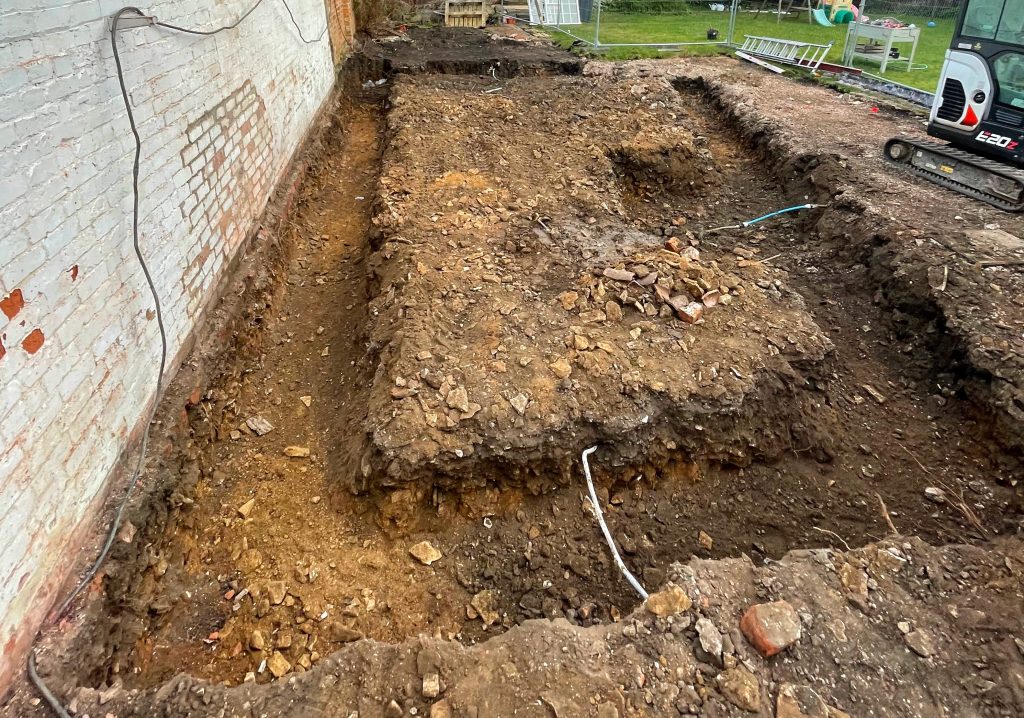5 Main Types of Foundations in the UK
Foundations are essential for any major building project and there are five main types of foundations used in the UK. Strip foundations are the most common type and involve digging trenches to a depth of around one metre, then filling them with concrete or hardcore and steel reinforcements.
Pad foundations are used when a single column needs supporting and involve digging down to a depth of around one metre, then pouring concrete into an appropriately-shaped hole.
A raft foundation is suitable for larger buildings that require more support, with layers of concrete slab laid directly onto the ground; piles may also be added if necessary.
Trench fill is similar to strip foundations but involves filling the trench with layers of material such as clay, sand or rubble before adding a layer of concrete.
Finally, bored pile foundations are created by drilling large holes in concrete columns which are connected together using reinforced steel beams; these are used where significant support is required due to poor soil conditions or deeper excavation.
While each type has its own advantages and disadvantages, it’s important to choose the best option for your project as this will affect its performance in terms of stability, durability and cost-effectiveness.
1. Strip Foundations
Strip foundations are an extremely economical and popular foundation type used in the construction of houses and other buildings. They consist of a concrete base that is poured to a minimum depth of 225 millimetres, upon which the walls of the foundation are built up to the level of the ground floor. This type of foundation is usually used when setting a building on firm, level ground that has been properly prepared.
The advantages of strip foundations lie primarily in their affordability; when compared to other foundation types such as piled or raft foundations, strip foundations are much cheaper. Additionally, they have a relatively quick installation time; once the ground has been levelled and prepared for building, it takes minimal time for workers to dig the trench, mix and pour the concrete, and then construct the walls from bricks or blocks. This makes them ideal for those who want to complete a project on a strict budget with limited time available.
Another advantage to strip foundations is that they can be extended over longer areas without extra support needed as long as there are no large openings in the wall created by windows or doors. Furthermore, these foundations can be adjusted if necessary by either deepening or raising them before laying flooring or walls on top. However, this ease of adjustment only applies when dealing with relatively shallow depths; anything deeper than 250mm should not be modified unless it is done by experienced professionals due to structural integrity issues.
Yet despite its many benefits, strip foundations also have certain disadvantages that must be taken into account before deciding whether they’re suitable for your particular project. One issue is proper drainage; if rainwater isn’t managed correctly through appropriate drainage systems it can lead to waterlogging which then affects the strength of these shallow foundations leading to damage down the line. Additionally, these types of foundations may not always be suitable for sites with rocky soils as this requires extra preparation – both in terms of clearing any obstacles from excavation as well as providing reinforcement – making them less economical than originally thought due to extra costs incurred.
Overall, strip foundations are an excellent choice for those looking for an economical solution with fast installation times but one must take into account all factors before deciding on this particular system such as soil conditions and drainage requirements. With careful planning and professional advice, you should be able to make use of this efficient method without compromising safety or causing excessive costs further down the line!
2. Trench Foundations
Trench foundations have become increasingly popular in recent years as they offer a cost-effective solution in areas with trees, unstable ground, or a high water table. This type of foundation involves digging out a trench and then filling it with concrete. It is more expensive in terms of materials but less labour-intensive than other forms of foundation such as strip foundations.
When considering whether to install a trench foundation, there are several factors that need to be taken into consideration. Firstly, the soil conditions must be taken into account; trenches should never be dug into soils that are likely to collapse or shift significantly. Secondly, the water table should also be inspected; if it is too high, the foundation may become submerged and cause structural issues down the line. Finally, any nearby trees can cause problems due to their root systems; it is important to investigate how far they extend and consider any potential effects on the foundation.
In terms of installation, trench foundations typically involve excavating an area up to 1.5m deep and then filling it with concrete. The depth of the excavation will depend on local soil conditions and requirements set out by building regulations. Reinforcement should also be considered during installation; steel reinforcement bars (rebar) or mesh can provide additional strength and stability throughout the life of the structure above it.
Once installed correctly, a trench foundation will last for many generations as long as there are no unexpected changes in local soil conditions or water tables. However, it is important to note that if nearby trees are removed or their root systems expand over time, this could affect their integrity. Therefore regular inspections should take place over its lifetime to ensure that everything remains safe and secure for those living beneath it.
Overall, trench foundations offer an economical solution for areas with challenging soil conditions or where there is an unusually high water table present. Although the installation may require more materials than some other types of foundation such as strip foundations, labour costs tend to remain low thanks to their minimalistic design approach – making them an attractive choice for those looking for robust construction without breaking the bank.
3. Pad Foundation
A pad foundation is a great choice for most lightweight structures. It can be used to provide stability, strength and support in areas with low-bearing soils or that require shallow foundations. Pad foundations are easier to construct than other types of foundations, as they don’t require deep excavations and don’t use large amounts of concrete. They often consist of a flat, solid slab or pad of reinforced concrete resting on compacted soil or gravel.
This type of foundation is commonly used for residential projects such as timber frame kits, as they can provide sufficient support while using up to 75% less concrete than conventional spread or strip footings. While they are generally more economical than other types of foundation, it’s important to note that pad foundations take more time and effort to install and may require additional labour costs.
Before beginning construction on a pad foundation, it’s essential that the soil is tested for bearing capacity to ensure the foundation will be able to prolong the structure’s lifespan without any issues. The shape of the pad should also be taken into account when designing the project – round pads are typically better suited for structures with higher loads while square pads are normally chosen when the bearing load is lower.
When installing a pad foundation, it’s crucial that all edges are kept level and uniform in order to ensure structural integrity. Additionally, during construction, proper drainage should be incorporated around the perimeter and within the slab itself in order to prevent water from pooling and weakening the structure over time.
As technology continues to advance, new materials have emerged over recent years which offer an alternative to traditional methods such as reinforced concrete pads. These include cellular sheets – which can provide an efficient yet cost-effective solution – as well as geogrids which are highly durable and come in various sizes depending on load requirements.
Overall, a pad foundation is an excellent option for those looking for quick installation times with minimal costs – while still providing adequate support for low-load structures. However, due care must be taken when selecting materials and designing layouts so that there aren’t any unexpected issues further down the line!
4. Raft Foundations
Raft foundations are an effective way to provide support for a building in areas with unstable ground, and they have become increasingly popular in recent years. Unlike other types of foundations which may be more cost- and labour-efficient, the raft foundation offers a higher degree of stability due to its reinforced concrete structure. This makes them ideal for use in mining areas where the ground is prone to shifting.
A raft foundation consists of a heavily reinforced concrete slab that is laid down beneath the entire footprint of the building it supports; it literally “floats” on top of the soil, providing an even frame for the building above. This uniform nature ensures that all parts of the building remain in perfect unison, eliminating any risk of instability or damage due to soil shifting. Installation of these foundations typically involves pouring a large slab that extends beyond the footprint of the building itself, then creating trenches below it and filling them with gravel or crushed stone, and then reinforcing this mixture with steel bars before pouring concrete over it. This process creates a very sturdy foundation that is designed to move as one unit with any seismic activity or subsidence.
In addition to providing stability against the movement in unstable soils, raft foundations also offer improved thermal insulation thanks to their mass character; by absorbing heat from inside during colder months and releasing it during hotter months, they help regulate interior temperatures more efficiently than other types of foundations. Furthermore, because these foundations transfer load directly downwards instead of relying on friction between soil layers for support as do shallow foundations, they can also provide greater structural strength without needing additional reinforcement measures like anchor bolts or footings.
Overall, raft foundations can be seen as a wise investment when considering building projects on land that may be subject to seismic activity or subsidence; while they may require more time and money than traditional shallow foundations, their added stability and efficiency make them well worth considering.
Pile foundations are a special type of foundation which are used to provide strong structural support for buildings in areas where the ground is particularly unstable or weak. Piles can be driven down much deeper than other types of foundations, making them an ideal choice for projects located in areas where soils are weak and the structure needs extra reinforcement.
5. Pile Foundations
Pile foundations involve driving cylindrical columns into the ground using special machinery. The cylindrical columns provide stability and strength to the building, and their shape helps to distribute the weight of the structure evenly throughout the soil. The size, shape, and position of each pile will depend on the size and type of structure being supported by it. Generally speaking, piles are more cost-effective for depths greater than two meters as it is often difficult to find suitable materials for other types of foundation systems at these depths.
The process of constructing a pile foundation begins with a preliminary investigation which involves collecting information about soil characteristics such as grain size distribution, water content, density, and compaction characteristics. All of this data is then used to determine if a pile foundation would be appropriate for the area or if another type of foundation would be better suited.
Once it has been established that pile foundations will work best for a given project, they can be constructed in several different ways depending on what is required by the engineering design specifications. One common method involves pre-drilling holes into which steel or concrete piles can be placed before being filled with concrete and reinforced with steel rebar as needed. Another technique involves driving prefabricated steel pipes through the soil until they reach a predetermined depth before filling them with concrete slurry or grout to create solid pillars within them. For additional reinforcement during construction, some projects may require that anchorage rods or cabling are installed between piles in order to minimize any lateral movement that may occur over time due to changes in soil or groundwater levels.
Regardless of how they are created or what materials are used in their construction, pile foundations offer many advantages when compared to other types of foundation systems such as shallow footing systems or rafts. The most significant benefit is that piles can be used in locations where soils may not have the sufficient bearing capacity for other types of systems due to weak strata or surface instability from high water tables or expansive clay soils that often cause settlement issues when used with traditional shallow footing systems. Furthermore, because pile foundations can go down much deeper than shallow footings, there is less risk associated with potential changes in soil conditions over time which could lead to settlement problems further down the line if not addressed correctly at the installation stage.
All things considered, pile foundations offer a highly effective solution when working with unstable soils and they can provide an excellent option for those looking for an economical way to create strong support structures without having to worry about potential settlement issues caused by changes in soil conditions over time. Matrix Structures UK
What foundations are used for houses UK?
Foundations are essential components of any construction, and houses in the UK usually rely on one of five types: strip foundations, trench fill foundations, pile foundations, raft foundations, and pad foundations. The type used will depend on factors such as soil type, building weight, water table level, and cost. Strip foundations are the most popular option for houses in the UK
What is the most common foundation type in the UK?
The most common foundation type in the UK is the strip foundation. It is an economical and popular type of foundation used in the construction of houses and other buildings
types of foundations for houses
There are several types of foundations commonly used for houses. The most common types of foundations used in the UK include:
Strip foundations: This type of foundation is a concrete base that is poured to a minimum depth of 225 millimeters, upon which the walls of the foundation are built up to the level of the ground floor. Strip foundations are usually used when setting a building on firm, level ground that has been properly prepared.
Trench fill foundations: This type of foundation is similar to strip foundations, but with the trench filled with concrete. This foundation is typically used on sites with clay soils or where tree roots are a problem.
Raft foundations: This type of foundation is a large, flat slab of concrete that is used to spread the weight of a building over a larger area. Raft foundations are typically used on soft, weak or waterlogged ground.
Pile foundations: This type of foundation is used on sites where the soil is unstable, or where the building is particularly heavy. Pile foundations involve the use of long, steel or concrete columns that are driven deep into the ground to support the weight of the building.
Pad foundations: This type of foundation is similar to strip foundations but consists of isolated footings that support individual columns or stanchions. Pad foundations are typically used on lightweight structures or on sites with a shallow layer of topsoil.
The type of foundation chosen for a house depends on the site conditions, soil type, and the weight of the building. A qualified structural engineer or architect can advise on the most appropriate type of foundation for a particular project






